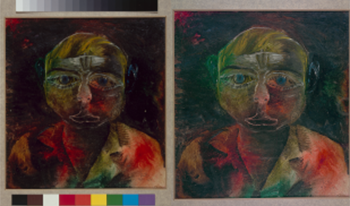
Displaying the past appearance of artworks by reversing degradation phenomena holds significant value for art historians, conservators, museum curators, educators, and the wider public, as it seeks to estimate the original artist intention. In this work, we aim to restore the past colors of a painting from documentary records done on reversal film photographs. The challenge with these photographs is that due to film-specific chromogenic processes, their colors are inaccurate with respect to the captured object. For this reason, we test the performance of four color correction methods in compensating for the color distortions inherent to each film type by using a dataset of reversal films of two color targets, X-Rite ColorChecker Digital SG and Coloraid IT-8. Furthermore, we apply the same method to detect changes due to aging and/or conservation treatments in the painting Junger Proletarier (1919) by Paul Klee, by comparing a color corrected film record from 1995 with a more recent digital capture of the painting from 2005. Our results indicate that the method which best accounts for the film chromogenic processes to reveal the actual colors of the photographed object is based on non-linear optimization using a neural network.
Irina-Mihaela Ciortan, Giorgio Trumpy, "FILM2PAINT: Transforming Photographic Documentation on Reversal Film into Paintings’ Accurate Colors" in Archiving Conference, 2024, pp 17 - 22, https://doi.org/10.2352/issn.2168-3204.2024.21.1.4
 Find this author on Google Scholar
Find this author on Google Scholar Find this author on PubMed
Find this author on PubMed